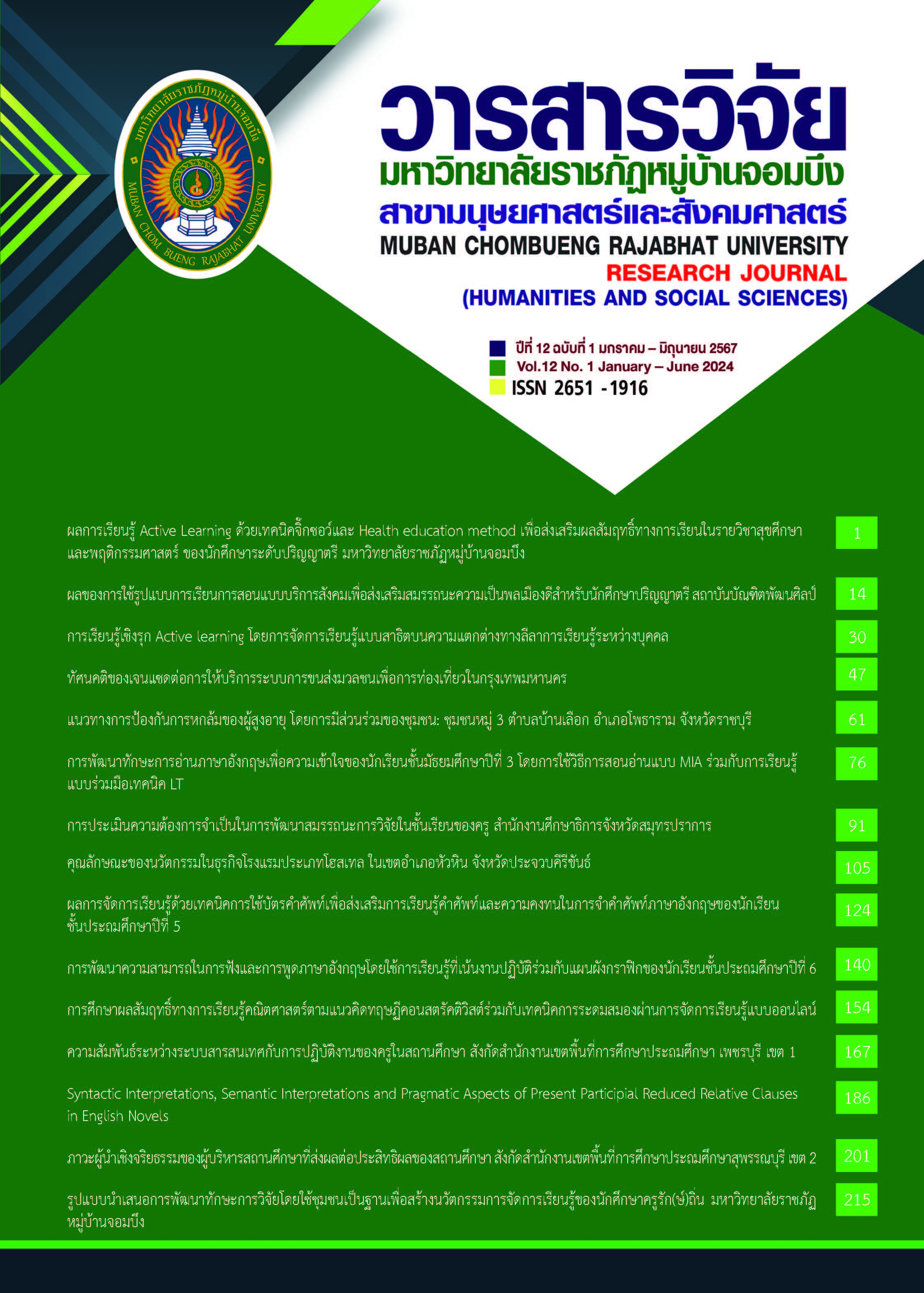การเรียนรู้เชิงรุก Active learning โดยการจัดการเรียนรู้แบบสาธิตบนความแตกต่างทางลีลาการเรียนรู้ระหว่างบุคคล
คำสำคัญ:
การเรียนรู้แบบสาธิต, การเรียนรู้แบบสถานการณ์จำลอง, การสอน, ไวยากรณ์จีนบทคัดย่อ
การวิจัยนี้มีวัตถุประสงค์เพื่อศึกษาความแตกต่างระหว่างบุคคลเกี่ยวกับลีลาการเรียนรู้ และผลการใช้รูปแบบการเรียนรู้เชิงรุก Active learning โดยการจัดการเรียนรู้แบบสาธิตและการเรียนรู้แบบสถานการณ์จำลอง ในการจัดการเรียนการสอนในรายวิชาการสอนไวยากรณ์จีน บนความแตกต่างทางลีลาการเรียนรู้ระหว่างบุคคล ใช้รูปแบบการวิจัยและพัฒนา (R & D) กระบวนการสอน กลุ่มเป้าหมาย ได้แก่ นักศึกษาระดับปริญญาตรี ปี 4 ภาคเรียนที่ 2 ปีการศึกษา 2564 จำนวน 2 หมู่เรียน รวมทั้งสิ้น 34 คน เครื่องมือที่ใช้ในการวิจัยประกอบด้วย 1) แบบสอบถามความแตกต่างระหว่างบุคคลเกี่ยวกับลีลาการเรียนรู้ 2) แบบสอบถามการเรียนการสอนในรูปแบบการเรียนรู้แบบสาธิต 3) แบบสัมภาษณ์และประเมินความพึงพอใจกิจกรรมการเรียนการสอนรูปแบบการสาธิตและสถานการณ์จำลอง วิเคราะห์ข้อมูลโดย หาค่าร้อยละ (Percentage) ค่าเฉลี่ยและส่วนเบี่ยงเบนมาตรฐาน ความแปรปรวน (Variance) t-test independent
ผลการวิจัย พบว่า 1) นักศึกษามีความชื่นชอบทั้งสามด้าน ชื่นชอบการเขียนตัวอักษรจีน ออกเสียงจีน การทำกิจกรรมร่วมกับเพื่อน ๆ ในระดับมาก ยกเว้นชื่นชอบการรายงานเนื้อหาหน้าชั้นเรียน ประกอบกับผลการวิเคราะห์ความแตกต่างการเรียนรู้ระหว่างบุคคล พบว่า ในภาพรวมผู้ตอบแบบสอบถามมีความมั่นใจ กล้าที่จะแสดงออก บรรยายหน้าชั้นเรียน อยู่ในระดับปานกลาง (𝑥̅ = 3.02) และมีความเข้าใจต่อการเรียนรู้เนื้อหา (ส่วนบุคคล) ภายในชั้นเรียนอยู่ในระดับปานกลาง (𝑥̅ = 3.26) 2) ผลการจัดการเรียนรู้แบบสาธิตและการเรียนรู้แบบสถานการณ์จำลองของความแตกต่างทางลีลาการเรียนรู้ระหว่างบุคคลของผู้เรียนทั้งสองกลุ่มมีความแตกต่างกัน จากการจัดการเรียนรู้แบบสาธิตและสถานการณ์จำลองที่เหมือนกัน ทางด้านการเตรียมพร้อมก่อนการเรียนทุกครั้ง การได้รับความรู้จากเนื้อหาการเรียนการสอนกิจกรรมภายในห้องเรียน การมีรูปแบบการสื่อสารความรู้ภายในเนื้อหาให้มีความเข้าใจ
เอกสารอ้างอิง
กรแก้ว พิเมยและสุพินดา เลิศฤทธิ์. (2564). การพัฒนาความสามารถการพูดภาษาอังกฤโดยใช้สถานการณ์จำลองในผู้ลี้ภัยผู้ใหญ่เขตพื้นที่กรุงเทพมหานคร. Academic Journal of MBU; Lanna Campus, 10(2), 26-34.
จิตณรงค์ เอี่ยมสำอางค์. (9 กันยายน 2015). เข้าถึงได้จาก Active Learning http://chitnarongactivelearning.blogspot.com
ทิศนา แขมมณี. (2551). ลีลาการเรียนรู้-ลีลาการสอน. วารสารราชบัณฑิตยสถาน,33(1), 68-94.
บุษกร เชี่ยวจินดากานต์. (2561). เทคนิคการวิจัยเชิงคุณภาพแบบกรณีศึกษา. Liberal Arts Review,13(25), 103-118.
มงคล เสนามนตรี. (2542). การพัฒนาแบบฝึกเสริมทักษะกระบวนการทางวิทยาศาสตร์ขั้นพื้นฐาน.วิทยานิพนธ์ปริญญาศึกษาศาสตรมหาบัณฑิตสาขาวิชาวิทยาศาสตร์ศึกษาบัณฑิตวิทยาลัยมหาวิทยาลัยขอนแก่น
วรรวิษา สำราญเนตรและนิตยา กออิสรานุภาพ. (2562). ความพึงพอใจในจัดการเรียนการสอนแบบใช้ สถานการณ์จำลองในการพยาบาลผู้ป่วยที่มีภาวะช็อคของนักศึกษาพยาบาลวิทยาลัย พยาบาลศรีมหาสารคาม. วารสารโรงพยาบาลสกลนคร, 64-75.
สุรางค์ โค้วตระกูล.(2565).จิตวิทยาการศึกษา.กรุงเทพ.จุฬาลงกรณ์มหาวิทยาลัย.
สุวิภา สุริยะปัญญาและศิริพงษ์ เพียศิริ.(2564). การพัฒนาหลักสูตรรายวิชาเพิ่มเติมภาษาจีน สู่เมืองพระยาแลเพื่อพัฒนาความสามารถด้านการฟังและการพูดภาษาจีนของนักเรียนชั้น มัธยมศึกษา ปีที่6โดยการจัดการเรียนรู้แบบสถานการณ์จำลอง. Silpakorn Educational Research Journal, 13(1), 323-335.
อดิเรก นวลศรี. (2015). การพัฒนาทักษะการสื่อสารภาษาจีนด้วยวิธี ตอบสนองด้วยท่าทางTPR ของนักเรียนชั้นประถมศึกษาปีที่ 4 โรงเรียน วัดคูยางสำนักงานพื้นที่การศึกษาประถมศึกษากำแพงเพชร เขต 1. Panyapiwat Journal, 7(1), 149-159.
Witkin,H.A.,Dyk,R.B.Paterson,H.F.,Good-enough,D.R., & Karp,S.A. Psychological Differentiation.New York:Wiley,1962.
ไฟล์ประกอบ
เผยแพร่แล้ว
รูปแบบการอ้างอิง
ฉบับ
ประเภทบทความ
สัญญาอนุญาต
ลิขสิทธิ์ (c) 2024 วารสารวิจัยมหาวิทยาลัยราชภัฏหมู่บ้านจอมบึง สาขามนุษยศาสตร์และสังคมศาสตร์

อนุญาตภายใต้เงื่อนไข Creative Commons Attribution-NonCommercial-NoDerivatives 4.0 International License.
วารสาร TCI อยู่ภายใต้การอนุญาต Creative Commons Attribution-NonCommercial-NoDerivatives 4.0 International (CC BY-NC-ND 4.0) เว้นแต่จะรุบุไว้เป็นอย่างอื่นโปรดอ่านหน้านโยบายของเราสำหรับข้อมูลเพิ่มเติมเกี่ยวกับการเช้าถึงแบบเปิด ลิขสิทธิ์ และการอนุญาต



